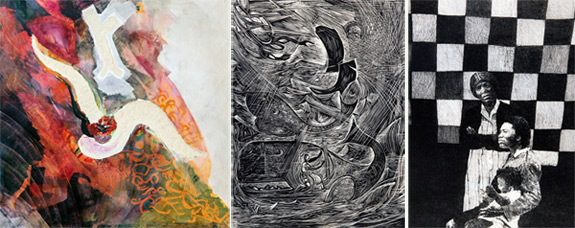I feel like I’m in the midst of a whirlwind of African American art. I keep bumping into familiar artists and their early works, discovering a different style of their works, and meeting new artists.
I’ve written two blog posts recently about finding early works by Philadelphia artists Reba Dickerson-Hill and Tanya Murphy. At another auction a fellow auction-goer directed me to a painting I had missed: It looked to be an early abstract by Philadelphia artist Benjamin Britt. I had seen the small work on the wall but had been so close to it that I did not recognize the barely discernable signature. Standing a few feet away, I saw that it was signed B. Britt.
The piece was markedly different from the Britt pieces I had seen before. His works evolved from Cubist in the 1950s to surrealism in the 1960s to minimalist in the 1970s and representational in the 1980s, according to one interpretation. The one at auction was more Cubist.
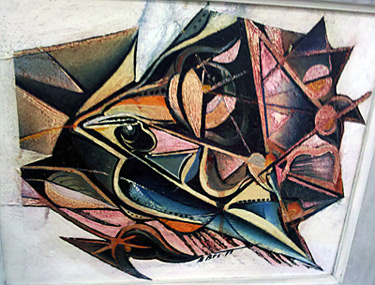
My other recent finds were a print by Charles Bibb, which I bought, and a still life by Samuel J. Brown, which I loved but whose price was way beyond what I pay for art at auction.
Let’s start with Bibb
I had just arrived at the auction house and headed straight to its back yard to browse the field of stuff from other people’s lives. As usual, there were cardboard boxes on two very long and extended tables under the overhead covering and many more underneath the tables. My eyes immediately fixed on a handful of paintings leaning against a wall on top of the first table I encountered.
I carefully flipped through them one at a time not expecting to find anything good among them. The auction house always keeps the good stuff inside. As I came to the last painting, I was pleasantly surprised. It bore an image of a man with large hands, his head and body swarthed in a royal blue cap and cape. I instantly recognized the style; it was the work of Charles Bibb.
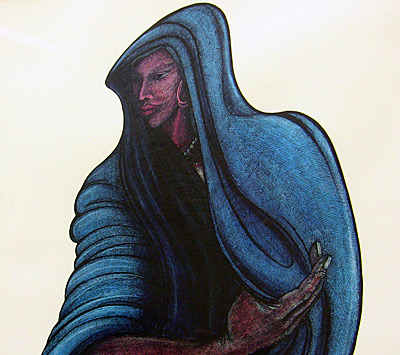
I realized that the image was not that of a man but a woman when I saw a large earring in the exposed left ear and a necklace around the neck. The hands were so big and masculine that I assumed this was a man. Most of Bibb’s works of women are larger than life, fluid in shape and usually bathed in color.
The painting was huge, standing about 3 ½ feet tall. It was beautifully frame – although the frame now had a few nicks – and it seemed to have been very well cared for. Thankfully, it hadn’t rained the night before or this print would have been ruined.
I’m pretty familiar with Bibb’s works, and even scored some posters that he had created in 2003 on the 163rd anniversary of Morehouse College in Atlanta. I believe that I may have seen others of his works at another auction, but I didn’t hang around long enough to bid on them.
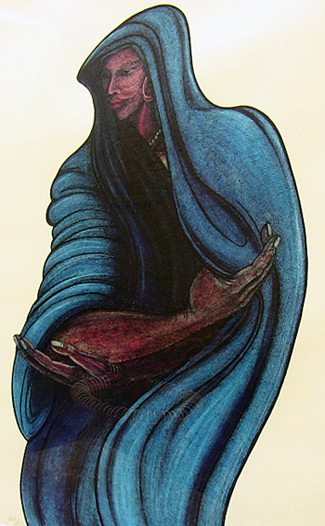
This print was part of a large series – 657 of 850. Bibb had signed his name and dated it ’92 in pencil, but the original painting had been done a year earlier. It did not have a title, so I later went searching for it on the web. It was alternately titled “Woman in Blue” and “Lady in Blue.”
I decided to bid on the print, although I don’t normally buy signed and numbered prints. Not anymore, at least. When I first started buying African American art from galleries – before I discovered auctions – signed and numbered prints seemed to be all that I could afford.
I was hoping that no one else would want the Bibb print, even though the image was African American. Usually, anything African American spurs heavy bidding because most of it is very marketable for dealers. Only one other person bid on it, and we went tit-for-tat until she gave up.
I ended up with the print, paying far less than the $1,100 to $1,200 asking price I found on the web for an unframed print, and the $2,000 price printed on the back of the auction print.
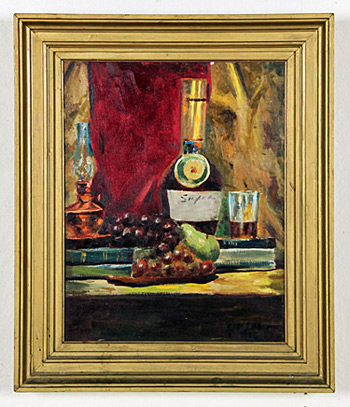
Samuel J. Brown
When I saw the Samuel J. Brown still life, I was very excited. I have two paintings by Brown – a painter, printmaker and sculptor who taught art as a public school teacher in Philadelphia – and both are of women. I saw this oil on canvas while I was previewing an upcoming auction on a website, and knew that I had to see it in person. So, when I got to the auction house, I started my search, which was hampered because the artworks on the walls were not numbered as they had been on the website.
Shortly, I found the Brown still life with grapes (1968) hanging among two other disparate pieces by the artist, along with several others by an artist whom I was unfamiliar with: painter and sculptor Tonnie Jones, with three paintings for sale (sold for $80 to $175). On other walls, I located a 1961 etching by the well-known artist James Lesesne Wells titled “Jonah and the Whale” (sold for $700) and a print titled “Generations” (sold for $50) by a New Orleans artist named Henry Casselli.
Once I saw the Brown still life, I wanted it. But since the auction was to be live on the web, I suspected that the price would be out of my range. With that in mind, I didn’t bother to leave an absentee bid, nor did I attend the auction.
Checking later, I learned that the painting had sold for $3,250 in intense bidding.
